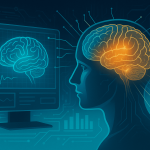
Brain Visualization Ethics: Balancing Innovation and Privacy
In today’s rapidly evolving tech world, brain visualization ethics sits at the crossroads of neuroscience and artificial intelligence. As researchers push the limits of decoding thoughts into digital visuals, the moral implications become impossible to ignore. Should we “see” what the brain thinks? For IT managers, neuroscientists, and data professionals, this ethical debate is as urgent as it is fascinating.
What Is Brain Visualization Ethics?
At its core, brain visualization ethics explores the moral boundaries of technologies that decode or display human cognition. Brain-computer interfaces (BCIs) and neuroimaging tools like fMRI translate mental activity into visible patterns. These systems can already predict choices, emotions, and even simple words.
Yet the ethical challenge is clear: when mental data becomes visible, who owns it? Who safeguards it? Ethical frameworks must evolve faster than the technology itself.
For a deeper dive into how brain computer interfaces work, explore Neuralink’s research page.
The Technology Driving Brain Visualization Ethics
The science behind brain visualization ethics blends AI algorithms, neural mapping, and big data analytics. Tools such as EEG headsets track electrical signals across the scalp, while advanced AI reconstructs images from brain activity.
A 2023 NIH study demonstrated that AI could recreate movie scenes based on participants’ brain scans with roughly 80% accuracy. But precision is not perfection errors could misrepresent someone’s intent or emotions, leading to dangerous misjudgments.
In IT and research environments, integrating such technology demands rigorous ethical review. False positives in cognitive data could carry the same consequences as flawed medical diagnostics.
Privacy Challenges Within Brain Visualization Ethics
As neural data becomes digitized, privacy risks escalate. Brain data could be hacked, manipulated, or monetized without consent. Imagine employers screening mental states for “loyalty” or advertisers targeting subconscious preferences.
Ethical frameworks recommend:
-
Encryption protocols to protect neural recordings.
-
Informed consent before any scan or visualization.
-
Data expiration policies ensuring timely deletion.
Visit Wired’s cybersecurity section for related insights on data security.
Within corporate IT structures, these protocols should integrate with data governance and compliance systems, similar to GDPR or HIPAA frameworks.
Medical Promise and Brain Visualization Ethics
Not all applications are controversial. Brain visualization ethics also guides remarkable medical breakthroughs. BCIs help patients with paralysis “speak” through neural commands. Therapists visualize emotional activity to track anxiety or PTSD treatments in real time.
At institutions such as Mayo Clinic, researchers use brain visualization to improve neurosurgery and rehabilitation. The ethical rule here is consent and benefit patients must always understand how their data is used and when it will be deleted.
Data Ownership Under Brain Visualization Ethics
The question of mental data ownership remains unsettled. When a company processes your brain activity, do they own the decoded output? Brain visualization ethics insists ownership should rest solely with the individual.
-
Personal autonomy: Thought data should never be treated as property.
-
Legal gaps: Few jurisdictions protect “mental privacy.”
-
Corporate policy: Companies must add brain data clauses to privacy policies.
Global Regulations in Brain Visualization Ethics
Internationally, some governments lead the conversation. Chile became the first nation to enshrine “neurorights” in its constitution, guaranteeing mental privacy and banning cognitive manipulation. Other countries may soon follow, recognizing brain data as the ultimate form of personal information.
Brain visualization ethics could soon form part of global data protection standards, alongside GDPR and ISO 27701. IT managers and policy strategists should prepare compliance pathways now.
Social and Economic Impact of Brain Visualization Ethics
Society will face complex consequences. If only wealthy individuals can afford brain-enhancing implants, inequality will deepen. Access to mental-health visualization tools could shape educational and healthcare outcomes.
Meanwhile, in law enforcement, neural imaging could one day be used as evidence—raising constitutional concerns about self-incrimination. Brain visualization ethics demands that such applications remain voluntary and transparent.
Universities, tech firms, and healthcare providers must collaborate to establish ethical boundaries that protect rights while encouraging innovation.
Future Directions for Brain Visualization Ethics
Looking ahead, AI-driven brain visualization may decode complex emotions or abstract ideas by 2035. However, without a clear ethical foundation, even well-intentioned research could cross dangerous lines.
Key future actions include:
-
Developing standardized consent frameworks.
-
Creating AI audit systems for brain-data algorithms.
-
Promoting open-access ethics guidelines for interdisciplinary teams.
For ongoing discussions in neuroethics and AI policy, see the internal post “AI Governance and Human Autonomy” on TechEthicsHub.
Conclusion
Brain visualization ethics is not just a philosophical concern it’s a practical necessity for the next decade of IT, medicine, and neuroscience. Balancing progress and privacy will determine whether these tools empower humanity or endanger it.
As innovation accelerates, our moral compass must keep pace. The time to define boundaries isn’t after thoughts become visible it’s now.
FAQs About Brain Visualization Ethics
1. What is brain visualization ethics?
It’s the study of moral principles guiding the decoding and display of brain activity through technology.
2. Who benefits most from it?
Neuroscientists, IT managers, healthcare providers, and policy leaders focused on data privacy.
3. What are the main risks?
Unauthorized access, data misuse, and discrimination based on cognitive profiles.
4. How accurate is it today?
Roughly 80% for basic images; emotional or abstract thought decoding remains experimental.
5. Will laws evolve soon?
Yes, global organizations and governments are drafting frameworks to ensure ethical neurotechnology adoption.
Author Profile

- Online Media & PR Strategist
- Hello there! I'm Online Media & PR Strategist at NeticSpace | Passionate Journalist, Blogger, and SEO Specialist
Latest entries
 ColocationNovember 12, 2025Colocation Security Model Implementation
ColocationNovember 12, 2025Colocation Security Model Implementation Artificial InteligenceNovember 7, 2025SAP AI Strategy Enterprise Advances and Developer Tools
Artificial InteligenceNovember 7, 2025SAP AI Strategy Enterprise Advances and Developer Tools Scientific VisualizationOctober 29, 2025Federated Learning Technology in Medical Privacy AI
Scientific VisualizationOctober 29, 2025Federated Learning Technology in Medical Privacy AI Scientific VisualizationOctober 29, 2025Brain Visualization Ethics: Balancing Innovation and Privacy
Scientific VisualizationOctober 29, 2025Brain Visualization Ethics: Balancing Innovation and Privacy

